Beyond the Trevi: 5 Must-See Iconic Fountains in Rome you can’t miss
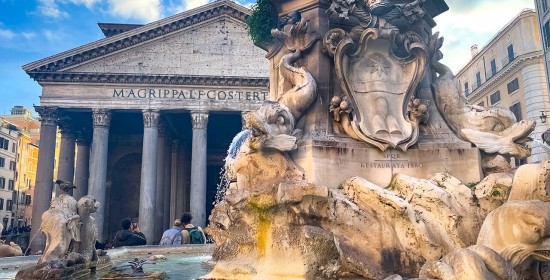
Buongiorno and welcome to Stefano Rome Tours, Rome’s leading tour company for private tours in Rome, and Rome Shore Excursions from Civitavecchia. When it comes to Rome, the Eternal City, one cannot help but be captivated by its rich history, stunning architecture, and the soothing melody of flowing water that seems to echo in Rome's many fountains, While the Trevi Fountain may be the most famous in Rome, the city boasts a collection of spectacular must-see iconic fountains in Rome that you can’t miss on your next trip to Italy.
Join us as we explore beyond the Trevi and discover the 7 must-see iconic fountains in Rome. While some of the fountains in this blog are part of our exclusive chauffeur-driven tours such as our top-selling Postcard Rome Tour, La Dolce Vita Rome private tour, and Rome Town and Country tour, you may also book a driver in Rome for the day and see only the sites you wish and tour at your own pace.
7 Must-See Iconic Fountains in Rome you can’t miss
1. The Fountain of the Four Rivers (Fontana dei Quattro Fiumi)
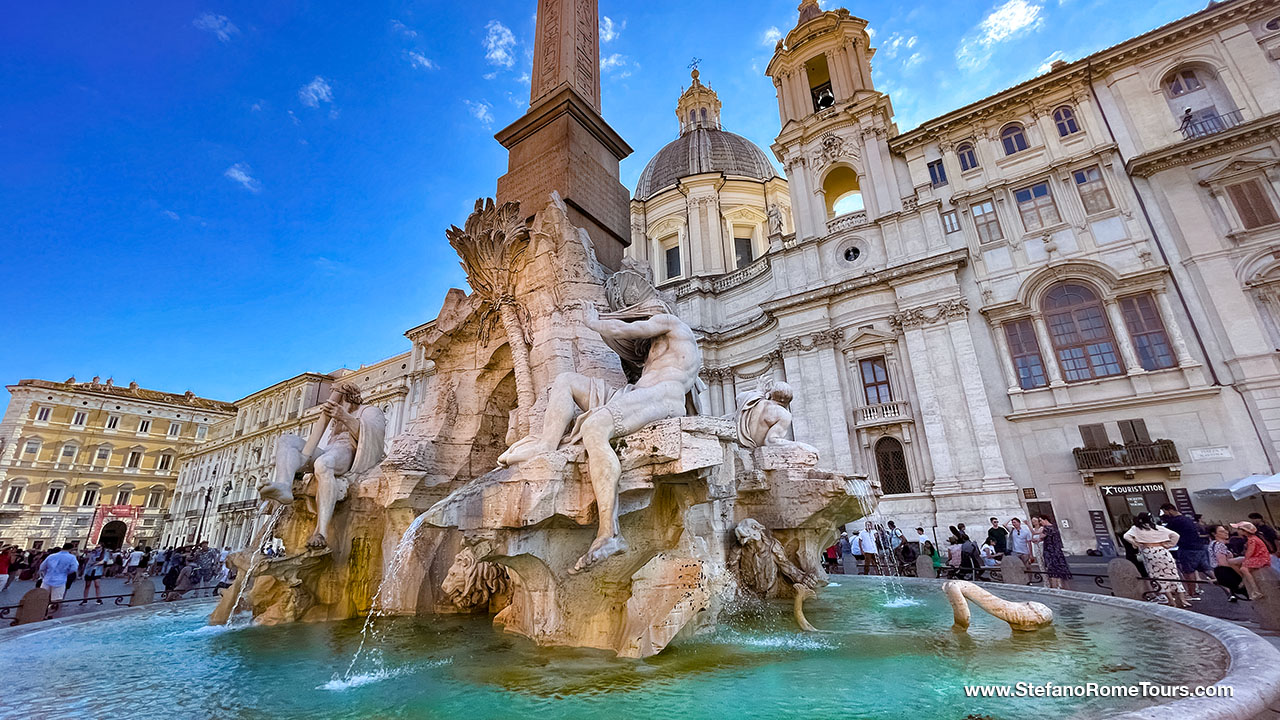
Located in the heart of Piazza Navona, the Fountain of the Four Rivers is a baroque masterpiece designed by the renowned sculptor Gian Lorenzo Bernini in the 17th century. Commissioned by Pope Innocent X in 1651, this masterpiece not only serves as a functional fountain but also as a symbolic representation of the global reach of the Catholic Church. The design and construction spanned from 1648 to 1651, and the fountain's inauguration marked a significant event in Roman art and architecture.
This awe-inspiring fountain represents the four major rivers of the world – the Nile, Ganges, Danube, and Rio de la Plata – through intricately carved sculptures. The dynamic composition and attention to detail make it a true marvel, standing as a pinnacle of Baroque art and design. The Baroque style, known for its dramatic flair, emotion, and grandeur, finds its epitome in Bernini's work. This fountain, with its lively and theatrical composition, showcases the essence of the Baroque period, leaving an indelible mark on the art world.
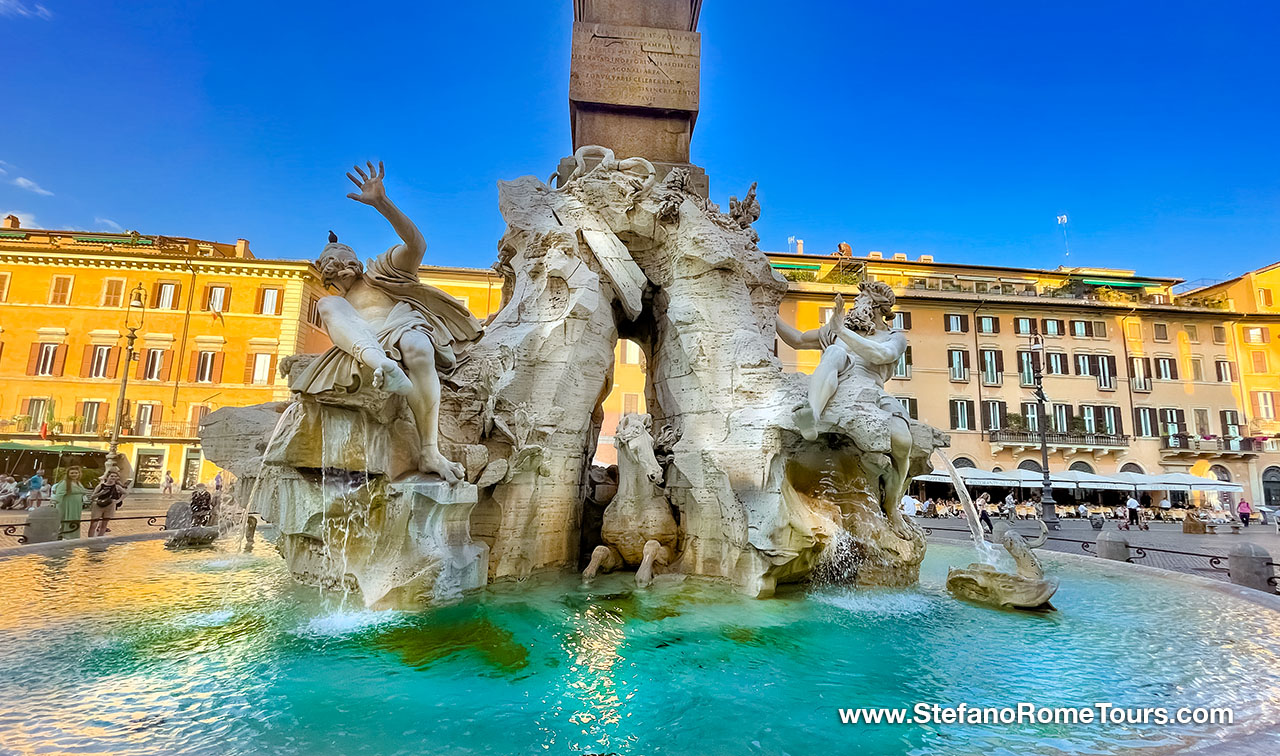
The fountain's central feature is an imposing rock structure, symbolizing the rocky sources of the four major rivers it represents. The Nile is depicted with a veil over its head, representing the mystery of its source. The Ganges is shown with an oar, symbolizing the navigability of the river. The Danube is portrayed with a horse, signifying Europe's dominion over the river, and the Rio de la Plata has a crowned Indigenous man, representing the Americas.
The dynamic composition is striking, with the figures seemingly caught in a moment of movement, frozen in time. Bernini's mastery is evident in the lifelike quality of the sculptures and the overall harmony of the ensemble. The fountain exudes drama, with each figure engaged in its unique narrative while contributing to the collective dynamism of the scene.
2. The Fountain of the Triton (Fontana del Tritone)
Located in Piazza Barberini, the Fountain of the Triton (in Italian: Fontana del Tritone) stands as a striking testament to the artistic genius of Gian Lorenzo Bernini. Commissioned by Pope Urban VIII, this seventeenth-century masterpiece not only serves as a decorative element but also functions as a practical utility, providing water to the heart of the city.
Constructed between 1642 and 1643, the Fountain of the Triton was commissioned by Pope Urban VIII, a patron of the arts and a member of the Barberini family. Situated near the entrance to the Palazzo Barberini, a palace designed and constructed by Bernini himself, the fountain was conceived as both a public ornament and a utilitarian structure for the city.
![]()
Artistic Innovation of the Fountain of the Triton
Carved from travertine, the fountain centers around a larger-than-life Triton, a minor sea god of Greco-Roman legend depicted as a muscular merman kneeling on a massive shell. The Triton's dramatic posture, with his head thrown back and arms raised to his lips, creates a sense of dynamic motion. A jet of water, once rising even more dramatically than today, spurts from the conch shell he holds.
The fountain's base features four dolphins intertwining the papal tiara with crossed keys and the heraldic Barberini bees in their scaly tails. This intricate detailing symbolizes the familial connection and patronage of the Barberini family, adding a layer of personal significance to the fountain.
The Triton Fountain, along with the Fountain of the Bees (in Italian: Fontana delle Api), sculpted by Bernini the following year, became a political statement during the First War of Castro. Both fountains were constructed around the same time, representing Urban's efforts to restore peace after a necessary conflict.
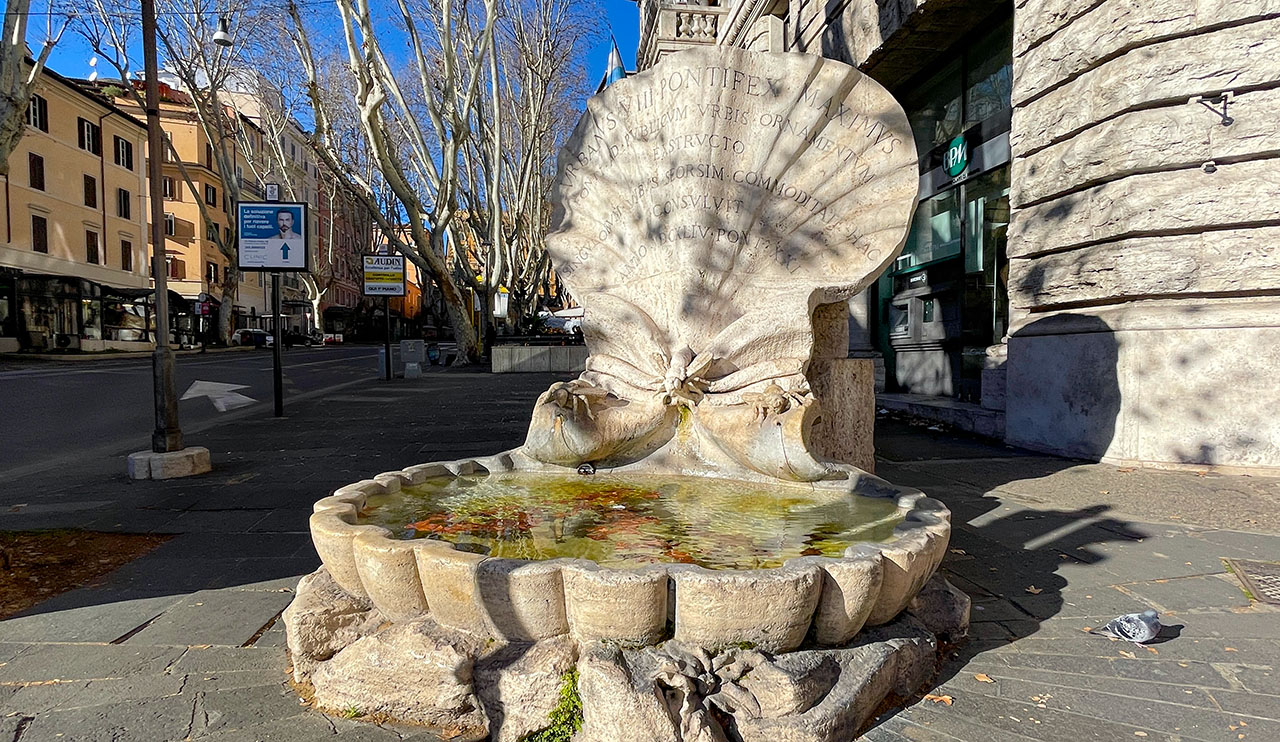
The legend associated with the Triton Fountain has made its way into Roman folklore. Similar to the tradition at the Trevi Fountain, it is said that visitors who throw a coin into the water (while facing away from the fountain) are guaranteed to return to Rome.
Despite the changes in the Piazza Barberini's setting over the centuries, with taller buildings and increased traffic, the Triton Fountain maintains its dramatic presence. Bernini's artistic judgment ensured that the fountain's impact endures, a timeless reminder of the fusion of art, myth, and utility in the heart of Baroque Rome.
3. The Fountain of the Pantheon (Fontana del Pantheon)
Situated in the Piazza della Rotonda, just in front of the Pantheon, this elegant fountain is a true gem, seamlessly blending elegance with historical significance. Commissioned by Pope Gregory XIII, this fountain, designed by Giacomo Della Porta in 1575 and sculpted by Leonardo Sormani, enriches the atmosphere of one of Rome's most revered squares.
The Fontana del Pantheon has witnessed several transformations since its inception. Originally constructed in the Renaissance era following the restoration of the Vergine aqueduct in 1570, it was initially composed of a mixed-line basin in African gray marble, adorned with circular arches and a baluster supporting a basin. The fountain featured unique details, including masks and dragon depictions, heraldic symbols of Pope Gregory XIII Boncompagni.
Over the years, the fountain underwent modifications. In 1662, the square's floor was lowered, the balustrade and steps were removed, and a large base was added, incorporating the mixtilinear motif of the basin. In 1711, Pope Clement XI Albani initiated further changes, replacing the upper basin with the central obelisk of Ramses II. Sculptor Filippo Barigioni designed the complex sculptural base, featuring dolphins at the corners and monumental coats of arms of the Albani family.
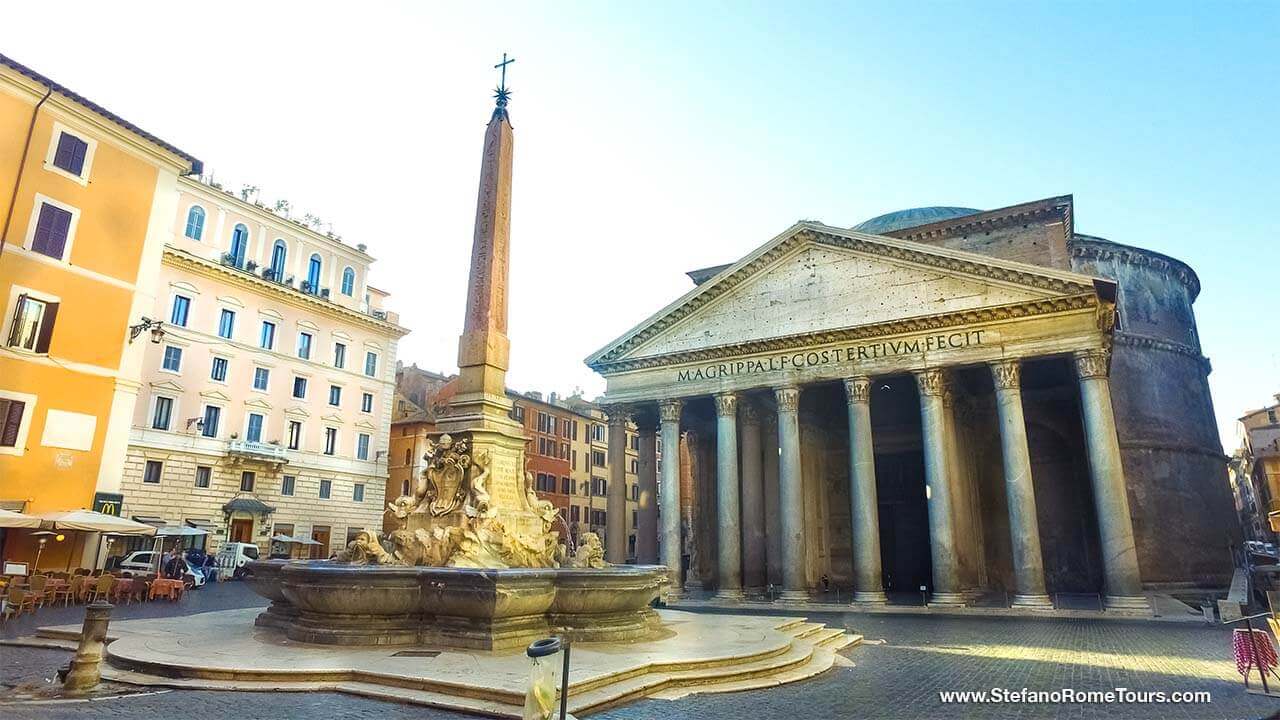
Architecture and Design of Fontana del Pantheon
The Fontana del Pantheon boasts a distinctive design that harmonizes with the majestic Pantheon nearby. The central obelisk, rising from a false travertine cliff, is supported by a sculptural base adorned with dolphins and monumental coats of arms. The surrounding marble basin, a remnant of the original Della Porta complex, adds a touch of timeless beauty to the fountain.
The fountain, as it stands today, is a captivating blend of Renaissance and Baroque elements, a testament to the evolution of architectural styles over the centuries. The incorporation of ancient Egyptian obelisks was a common feature in Baroque Rome, symbolizing the city's connection to classical antiquity.
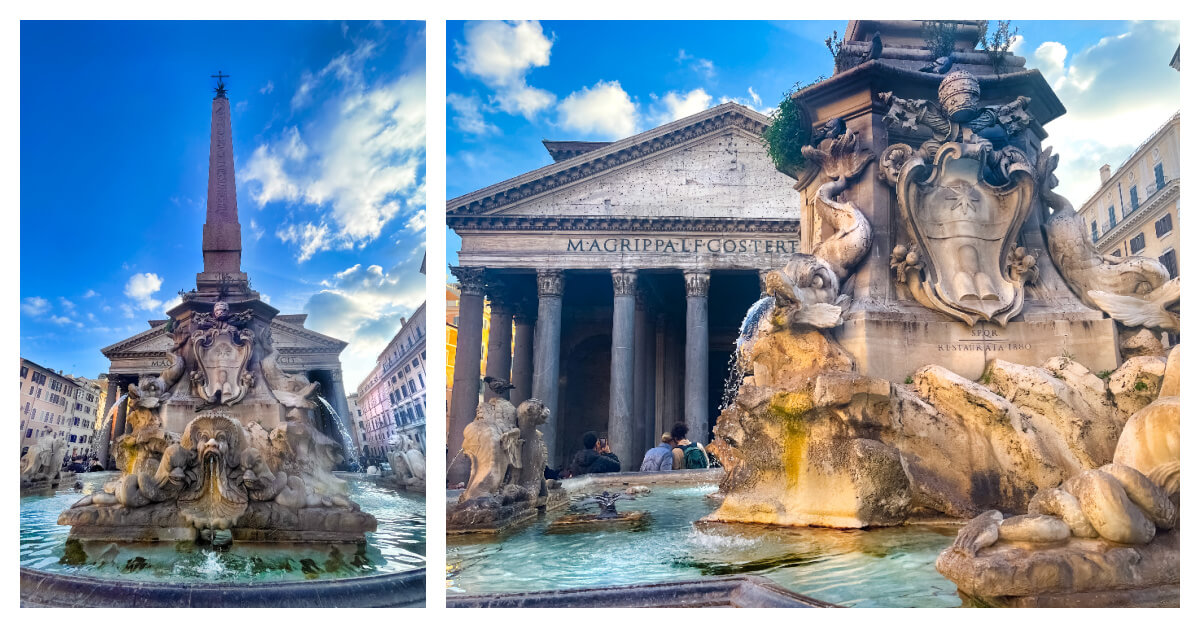
Legacy and Symbolism of Fontana del Pantheon
The Fontana del Pantheon not only serves as an exquisite decorative element but also embodies the rich history and symbolism of Rome. The Egyptian obelisk, once located in Iseo Campense and transported to its current location, carries a sense of ancient grandeur. The incorporation of coats of arms and inscriptions by Pope Clement XI further solidifies the fountain's connection to the Albani family and the papal patronage of the arts.
4. The Fountain of the Naiads (Fontana delle Naiadi)
At the heart of the bustling Piazza della Repubblica, the Fountain of the Naiads is a testament to the marriage of classical mythology and artistic ingenuity. Designed by architect Alessandro Guerrieri in 1888, this enchanting fountain has evolved over the years, culminating in a masterpiece that beckons visitors into the realm of myth and water.
The fountain's origins can be traced to a desire to showcase water from Rome's Acqua Pia Antica Marcia, a restoration of the ancient Aqua Marcia commissioned by Pope Pius IX. Its construction, initiated in 1888, aimed to create a monumental presence along Via Nazionale.
![]()
Sculptural Ensemble of the Fountain of the Naiads
The Fountain of the Naiads is a visual symphony, with a circular concrete basin housing a central water jet and lateral jets. Surrounding the basin are four bronze sculptures, each depicting a Nymph representing different forms of water. The Nymph of the Lakes, accompanied by a swan; the Nymph of the Rivers, resting on a river monster; Oceanina—the Nymph of the Oceans—taming a wild horse symbolizing waves; and the Nymph of Groundwater, reclining on a dragon's back.
At the fountain's center stands a powerful sculpture of the sea god Glaucus, an embodiment of dominance over natural forces. Reminiscent of Gian Lorenzo Bernini's style, Glaucus, a naked and muscular figure, holds a dolphin from whose mouth the central jet emerges, creating a captivating display that melds myth with the physicality of water.
5. The Fountain of the Acqua Paola
Perched atop Janiculum Hill, the Fountain of the Acqua Paola (also referred to as Fontanone del Gianicolo and Fontana dell'Acqua Paola), beckons those seeking a breathtaking view of Rome. This monumental fountain, erected in the early 17th century, stands as a testament to Pope Paul V's commitment to providing clean drinking water to the residents of Janiculum Hill, blending architectural grandeur with scenic beauty.
Built in 1612, the Fountain of the Acqua Paola holds historical significance as it marks the culmination of the restoration of the Acqua Paola aqueduct by Pope Paul V. Positioned near the church of San Pietro in Montorio, this fountain became the first major fountain on the right bank of the Tiber River.
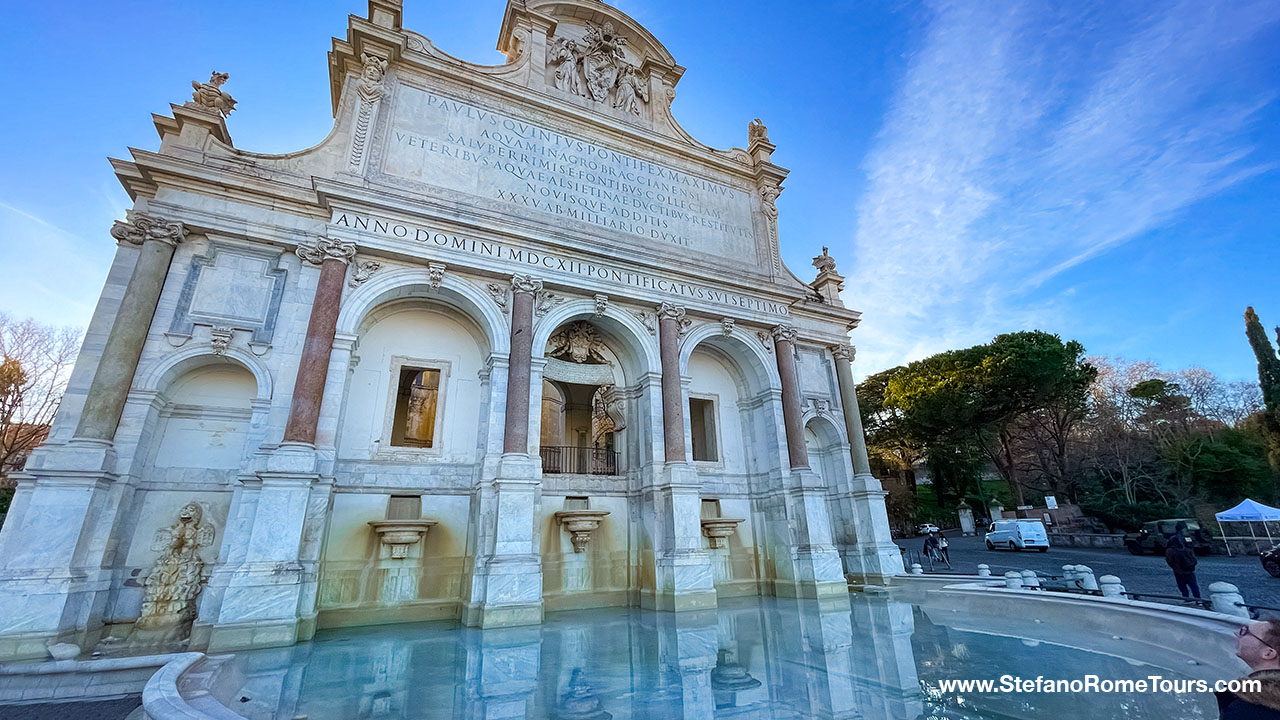
Inspiration and Design of The Fountain of the Acqua Paola
The fountain draws inspiration from the earlier Fontana dell'Acqua Felice, constructed during the pontificate of Pope Sixtus V. Pope Paul V, recognizing the need for a clean water source for Janiculum Hill residents, decided to rebuild and extend the dilapidated Acqua Traiana aqueduct. Giovanni Fontana and Flaminio Ponzio, the architects behind the Fontanone, crafted a design that utilized white marble sourced from the ruins of the Roman Temple of Minerva in the Forum of Nerva.
The fountain features a massive gateway with five arches through which water arrives, crowned by the papal tiara and keys. Above, the Borghese family coat of arms is supported by angels, and an inscription lauds Pope Paul V for the invaluable gift of water to the district.
The Fontana dell'Acqua Paola, with its imposing structure and thematic representation, left an indelible mark on Roman fountains. Its design served as a source of inspiration for the iconic Trevi Fountain, showcasing the enduring impact of Baroque art and architecture on the city's landscape.
6. Fontana dell'Acqua Felice ( Fountain of Moses)
Located in Piazza San Bernardo next to the Church of Santa Maria Vittoria, the Fontana dell'Acqua Felice, affectionately known as the Fountain of Moses, stands as a testament to Pope Sixtus V's vision and determination. This monumental fountain was constructed between 1585 and 1588, this monumental fountain marked the culmination of the restoration efforts on the Acqua Felice aqueduct, an initiative undertaken by Pope Sixtus V to ensure a clean water supply for the people of Rome.
At the onset of Pope Sixtus V's reign, Rome faced a scarcity of clean drinking water, with the Aqua Vergine being the only functioning aqueduct. Pope Sixtus V, also known as Felice Peretti, took up the challenge of restoring various aqueducts, renaming the Acqua Alessandrina as Acqua Felice in his honor. The fountain at the terminus of this restored aqueduct marked a historic milestone, being the first new monumental wall fountain in Rome since antiquity.
![]()
History, Architectural Struggles, and Triumphs of Fontana dell'Acqua Felice
Designed by the accomplished Domenico Fontana, the fountain takes the form of an ancient Roman triumphal arch, capturing the essence of classical aesthetics. Positioned at the intersection of Largo Santa Susanna and Via Venti Settembre, the Fontana dell'Acqua Felice adorns the Quirinal Hill, creating a picturesque scene complemented by the nearby churches.
The initial attempt to build the aqueduct faced challenges, with architect Matteo Bartolini's miscalculations leading to insufficient water flow. Giovanni Fontana took charge of the project, completing it by June 1587. The fountain, an architectural triumph, features an inscription honoring Pope Sixtus beneath angels holding the papal coat of arms.
![]()
Water flows from the statues into basins, where four lion sculptures, replicas of Ancient Egyptian originals, once adorned a monumental fountain dedicated to Marcus Agrippa in front of the Pantheon. The revitalization of the Quirinal neighborhood is further symbolized by the flowing water, as it transformed what was once a rustic area into a thriving urban district.
While the statue of Moses faced criticism for its size, the Fontana dell'Acqua Felice achieved its political and social objectives. It became a powerful statement of the Catholic Church's commitment to serving the needs of the people, countering the backdrop of the Protestant Reformation. Simultaneously, it played a pivotal role in reviving the Quirinal neighborhood, turning it into a vibrant urban hub with a reliable drinking water supply.
Iconography and Symbolism of Fontana dell'Acqua Felice
The Fontana dell'Acqua Felice boasts rich iconography, blending biblical and political motifs. The central arch is crowned by a striking statue of Moses, sculpted by Leonardo Sormani and Prospero da Brescia in 1588. The left bas-relief, often associated with Aaron, and the right bas-relief by Flaminio Vacca and Pietro Paolo Olivieri, contribute to the overall narrative, drawing parallels between the achievements of Moses and Pope Sixtus V in bringing water to Rome.
7. Fontana delle Tartarughe (The Turtle Fountain)
The Turtle Fountain (in Italian: Fontana delle Tartarughe), is a timeless masterpiece of late Italian Renaissance design, located in Piazza Mattei within the Sant'Angelo district of Rome. Constructed between 1580 and 1588, this fountain is a testament to the collaborative brilliance of architect Giacomo della Porta and sculptor Taddeo Landini. Renowned for its grace and charm, the fountain has become an integral part of Rome's artistic and historical legacy and remains a timeless expression of Renaissance elegance.
Commissioned in the wake of the restoration of the Acqua Vergine aqueduct by Pope Gregory XIII, the Fontana delle Tartarughe was one of eighteen fountains erected to quench the thirst of the Roman population in the 16th century.
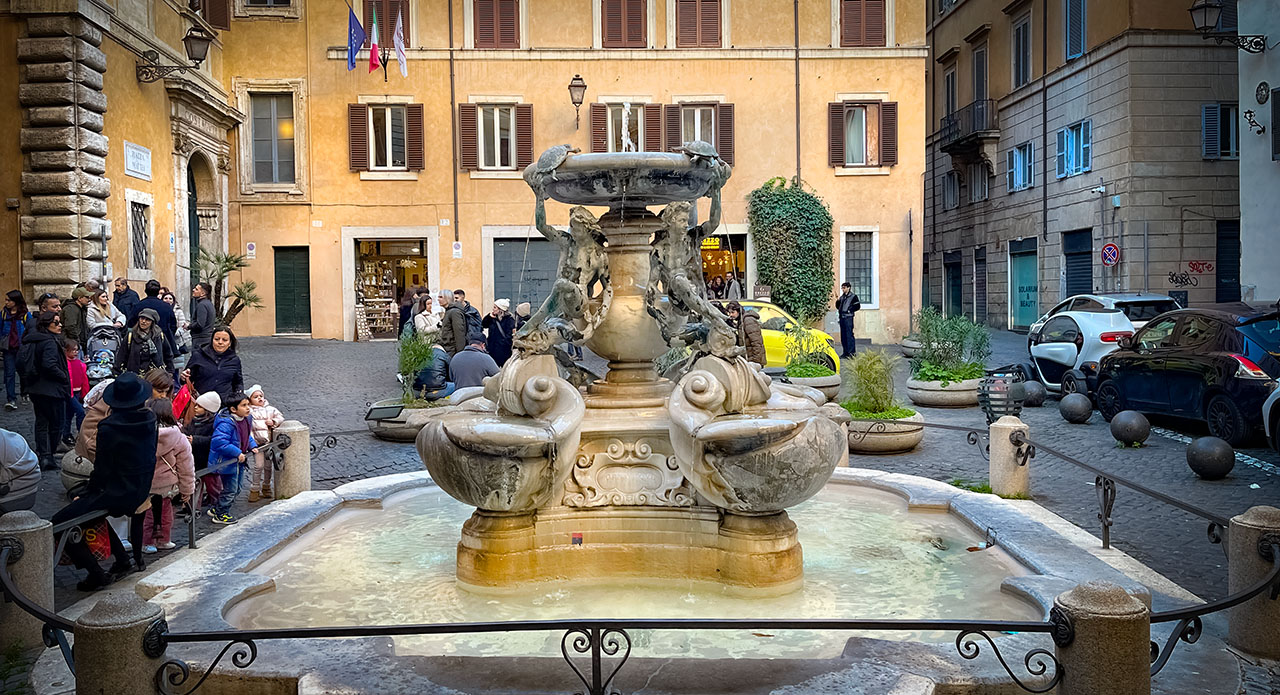
Muzio Mattei: A Private Patron's Vision
Unlike many fountains built for popes, the Fontana delle Tartarughe was commissioned by Muzio Mattei, a prominent member of the House of Mattei—a family of bankers and politicians with roots tracing back to the early Roman Papareschi family. Muzio Mattei played a pivotal role in influencing the fountain's location, choosing the quaint Piazza Mattei in front of his residence.
In 1580, the fountain's water channel was redirected to Piazza Mattei, thanks to an agreement between the Roman authorities and Muzio Mattei. As part of the arrangement, Muzio agreed to cover the fountain's maintenance costs and pave the square—an extraordinary instance of a private patron shaping Rome's urban landscape.
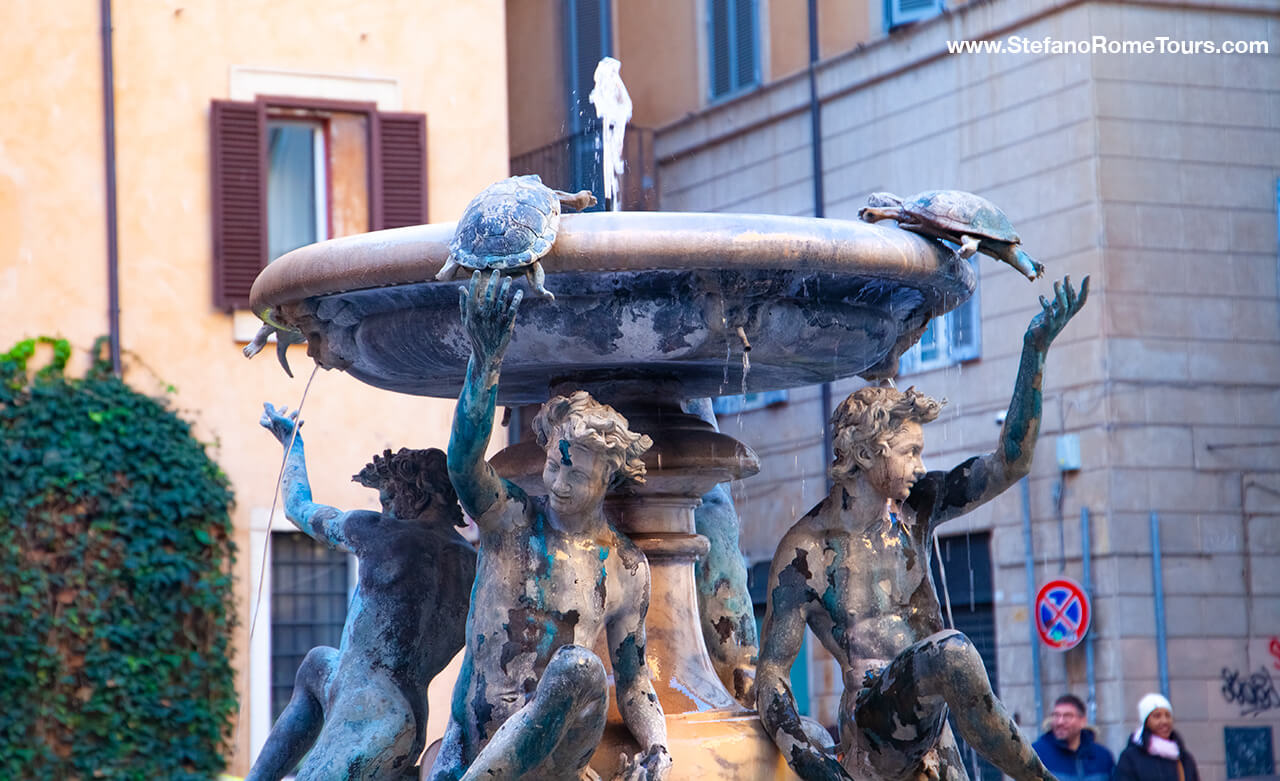
Design and challenges of the Fontana delle Tartarughe
Architect Giacomo della Porta's design for the Fontana delle Tartarughe was a departure from the typical Renaissance fountains. The fountain features a single vasque on a pedestal, from which water gracefully spouts upwards before cascading into a polygonal basin. The striking element of the design was the addition of four bronze ephebes, or young men, and eight dolphins, sculpted by Taddeo Landini.
The bronze figures, originally intended to support dolphins spouting water, were created in a mannerist style, possibly inspired by Bartolomeo Ammannati's work in Florence. The fountain's square basin, circular vasque, and surrounding elements combine to create a harmonious composition that captivates onlookers.
The Fontana delle Tartarughe faced immediate challenges related to water supply, common to all fountains connected to the Acqua Vergine aqueduct. The solution involved modifying the fountain soon after its completion, with four dolphins being removed due to low water pressure. This modification gave rise to a single upward jet of water, which filled the basin and drained through the mouths of putti into the lower basin.
Turtles, Dolphins, and Restoration of the Fontana delle Tartarughe
In 1658 or 1659, during a restoration ordered by Pope Alexander VII, bronze turtles were added to the fountain, positioned around the upper vasque. Attributed to either Gian Lorenzo Bernini or Andrea Sacchi, these realistic turtles contributed to balancing the composition and offering a purpose for the upraised arms of the bronze figures.
Throughout its history, the Fontana delle Tartarughe underwent various restorations, including a notable one in 2006 that preserved its marble and bronze elements. The fountain, equipped with a water purification system, continues to grace Piazza Mattei, enchanting visitors with its timeless elegance.
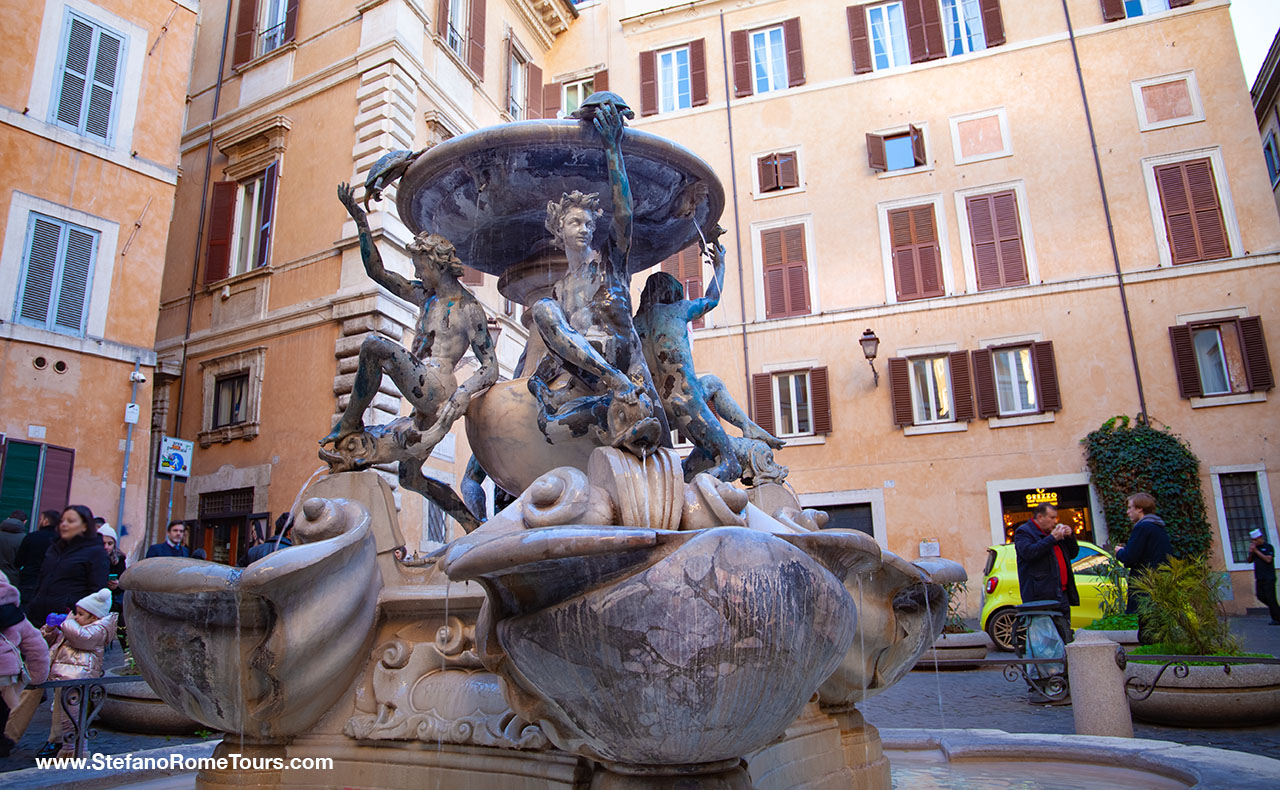
A Legend of Love and Deception
Adding a touch of romance and intrigue to the Fontana delle Tartarughe is a popular Roman legend. It tells the tale of Duke Muzio Mattei, who, supposedly ruined by gambling, orchestrated the construction of the fountain overnight to win the favor of his beloved's wealthy father. The legend suggests that the closed window overlooking the fountain was a symbolic act to commemorate this event.
While skeptics argue the practical challenges of constructing such a complex fountain in a single night, defenders of the legend point to the historical timeline and connections between the Mattei family's residences and the fountain's construction.
While the Trevi Fountain may steal the spotlight, Rome's fountains are a treasure trove waiting to be discovered. These seven iconic fountains offer not only artistic brilliance but also a glimpse into the city's rich cultural and historical tapestry.
So, the next time you find yourself wandering through the charming streets of Rome, be sure to venture beyond the Trevi and immerse yourself in the splendor of these must-see fountains. Your Roman adventure awaits!
Are you cruising to Italy?
If you are stopping in Rome for the day on a shore excursion from Civitavecchia, check out our Postcard Rome Tour for Cruisers, La Dolce Vita Rome Private Excursion, or you may book a driver in Rome from Civitavecchia.
If you are staying in Rome post-cruise, explore our Rome Post Cruise Tours from Civitavecchia such as Post-Cruise Postcard Rome from Civitavecchia, Post Cruise La Dolce Vita from Civitavecchia, and Post-Cruise Rome and Countryside from Civitavecchia.
We also offer Rome Pre-Cruise Tours with pick up from Rome hotel and drop off in Civitavecchia for cruisers staying in Rome before their cruise.
Thank you for reading our travel blog 5 Must-See Iconic Fountains in Rome you can’t miss on your next trip to Italy, and for choosing Stefano Rome Tours for your private tours in Italy and Shore Excursions from Civitavecchia. We look forward to sharing Bella Italia with you!
